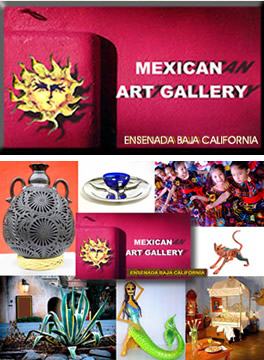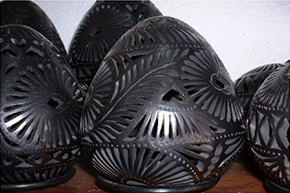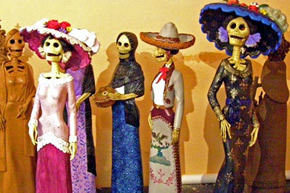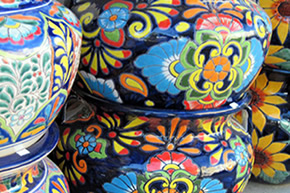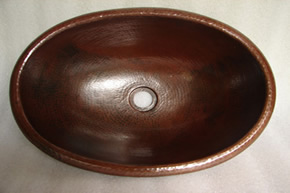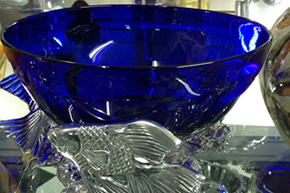In pre-colonial times, local Indians mined for copper in various regions of Mexico including the state of Michoacan in Central Mexico and used it to manufacture all kinds of wares and artwork. In 1538, the Spanish missionary, Vasco de Quiroga, established various schools, hospitals and libraries to educate and care for the local Indians of Central Mexico. In Michoacan he came to be regarded as "Tata" Quiroga, where he taught local Indians to work wood and copper in a more efficient manner. In the town of Santa Clara del Cobre, copper smithing became the town's mainstay, eventually making it famous for these skills. By the 17th century, a great demand for hand hammered copper kettles (pre copper sink) made in Santa Clara, largely supported the economy of the entire town. By the 20th century, however, the demand for these kettles almost disappeared to the point where only a few trained craftsmen were still capable of producing objects of high quality in the traditional way.
Copper mined in Mexico since pre-colonial times was used to make art, as well as practical wares. Hand-hammered copper kettles were in great demand in 17th century Mexico, and this technique was used to make copper sinks in the 20th century.
In the 1940s, artisans in Santa Clara renewed interest in traditional hammered copper crafts, which popularized the copper sink. Artisans that produced traditional copper kettles started producing also more decorative plates, copper vases, sinks and stylized copper containers.
Artisans make the copper sinks in three main styles: bathroom, kitchen and bar/prep sinks. They can also be crafted in a farmhouse apron style, which has an exposed panel in the front, but is otherwise under-mounted or dropped in.
The hammered pattern featured in Mexico's copper sinks ages over time. As the exterior ages, oxygen darkens the surface, creating a finish known as a patina. The patina has antimicrobial properties that kill pathogens like e-coli and staphylococcus after two hours. Better quality sinks are made of at least 98 percent copper, are lead free, and use a minimum 18-gauge thickness to ensure the sink retains its shape.
The natural patina of a Mexican copper sink needs very little care beyond soap and water. Harsh chemicals may remove the patina, and acids such as lemon juice can leave pink marks. Copper sinks covered with a wax coating will need to be waxed every few days, and lacquered finishes will wear off over time. To retain a shiny copper finish, a copper cream can be used. In all cases, strong cleaners should be avoided.

Oaxacan black clay or black pottery is a traditional, pre-Columbian art form of Oaxaca, Mexico. Until the 1950s, local artisans originally used the unique local clay to create ceramic containers for the use of transporting mescal from hillside farms to sell in the local communities. Created by well-known and respected artisans in Oaxaca, Mexico...
Read More
Noble, stately and proud, La Calavera Catrina – or the "Skeleton of the Female Dandy" - has been an icon of Mexican Pop Art since the days before the Mexican Revolution. Often associated with the Mexican holiday, Día de los Muertos (Day of the Dead, November 2nd), the true history of La Catrina is one of politics and revolution...
Read More
Alebrijes are carved wooden figures created by Oaxacan artisans. They have become so popular that even the world’s most respected Spanish language authority, the La Real Academia de la Lengua Española, Spanish Royal Academy, has included the term “Alebrijes” in its official Spanish language dictionary. The term “Alebrijes” originated from...
Read More
The Talavera pottery has its roots in the Arab-Andalusia culture in Spain. About 8 centuries ago Arab potters settled in a location now days known as Talavera de la Reina and established and developed the techniques and procedures to create the earthenware known as Majolica. The word Majolica originated in Italy and it refers to a process that the Italians used...
Read More
In pre-colonial times, local Indians mined for copper in various regions of Mexico including the state of Michoacan in Central Mexico and used it to manufacture all kinds of wares and artwork. In 1538, the Spanish missionary, Vasco de Quiroga, established various schools, hospitals and libraries to educate and care for the local Indians of Central Mexico. In Michoacan...
Read More
The history of Mata Ortiz, both the village and the pottery, can be traced through the archeological remains of nearby Paquimé, a pre-Columbian city state. From its modest beginnings around 700ADE, Paquimé grew into the center of political and commercial life of the Rio Grande River Valley. By its peak in the 14th century, Paquimé boasted....
Read More
Pewter is a wonderful metal with a long history. The origin of the word Pewter is not fully known, but it is probably an English modification of the word spelter. It was adopted with only slight variation by most of the continental European nations. Some people think of Pewter as a cheap substitute for Sterling silver but this it is not. Pewter is a splendid metal...
Read More
In each country or culture where kites have been used, the people there developed special names for them. These names reflected the ideas that people had about their kites, the way they looked, or the reasons they flew them. In English, the word "kite" is also the name of a graceful bird. In Mexico, the word for kite is "papalote". That's also the Mexican...
Coming Soon

